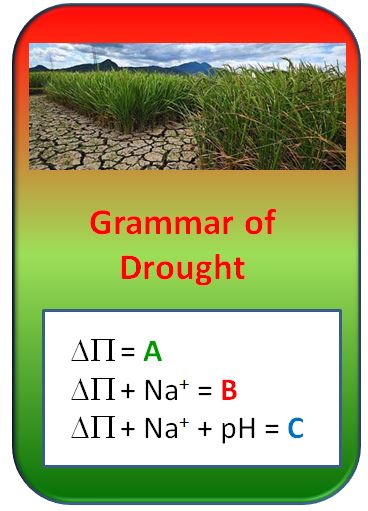2016_04: Intelligent Rice
What is the topic?
Adaptation to adverse conditions is the survival strategy for plants - they cannot run away, when they do not like their environment. We are interested in the question, how the plant can respond appropriately to different challenges. When we investigated the underlying molecular events, it turned out that the molecules, employed for the early responses, are mostly identical. The molecular nature of early signals can therefore not account for the differences in the response. Over time we have developed the concept of a "grammar for stress responses", whereby, similar to human language, combinations of signals generate new meaning. This so called signature hypothesis was now tested in a proof-of-concept study:
How did we proceed?
Osmotic stress is a central and global problem for agriculture: drought, soil salinity (in consequence of artificial irrigation), and alkalinity are expanding and cause considerable problems for society. These three versions of stress require different adaptations on side of the plant - for instance, in order to cope with salinity, cells pump sodium ions into the vacuole to sustain the turgescence needed for growth, while safeguarding the sensitive proteins in the cytoplasm from being destroyed by sodium ions. This strategy would not help against drought stress, though, because sodium ions are not relevant here. In contrast to salinity stress, roots have to stiffen their cell walls to penetrate deeper into the hard soil and extract the last residues of water. How can a plant decide upon the best strategy? These three versions of stress correspond to different combinations of individual stress factors: in case of drought, it is the osmotic gradient between root and soil, in case of salinity, dangerous sodium ions penetrate into the cell in addition to this osmotic gradient, and in case of alkalinity, the plant has to face a triple combination of osmotic gradient, ionic stress, and rising pH. We have now confronted a rice variety from Egypt with these three types of stress. What was different from other studies in stress physiology: we carefully adjusted the severity such that the osmotic component of the three treatments was always the same and we conducted the study comparatively, strictly controlling that all other parameters were comparable.
What was our question?
We asked, whether the plant during its response to a combination of individual stress factors, will just produce a response that is composed of the individual responses to each single stress factor. The response to salinity would then be just the response to the osmotic component added up by the response to the ionic component. Alternatively, the combination of individual stress factors might be perceived as something qualitatively different - in the same way as we sense the sum of "blue" and "yellow" as "green". We addressed this question by a comprehensive approach, whereby we addressed different levels of organisation (growth, stomatal aperture, ion transport, ion balance, accumulation of activated oxygen species, activation of resistance genes, formation of stress hormones).
What was the answer?
The plants responded clearly in a holistic manner - "green" was thus more than just the sum of "blue" and "yellow". Salinity stress evoked a qualitatively different response than drought stress, and alkalinity produced a third, qualitatively different, type of response. In this general picture we also found several surprising details - a response observed during salinity stress, was not found in alkalinity stress, although the ionic and osmotical component that activated this response, were still acting. We also found evidence for the opposite case: the combination of individual stress components could produce a response, which was neither seen for any of the individual components alone.
What does this mean?
The stress responses of plants are complex and holistic. The whole is more than the sum of its parts. Plants are obviously able to use combinatorial rules to distinguish different versions of osmotic stress and to activate a qualitatively different (but always meaningful and appropriate) adaptive response. The analogy with colour vision is evident. Although plants appear at first glance static and "stupid", they are apparently able to dissect even complex conditions and to respond in a rational and appropriate way. The ability to dissect complexity and to act appropriately is normally designated by the term "intelligence".
Publication
124. Hazman M, Hause B, Eiche B, Riemann M, Nick P. Different forms of osmotic stress evoke qualitatively different responses in rice. J Plant Physiol 202, 45-56 - pdf

